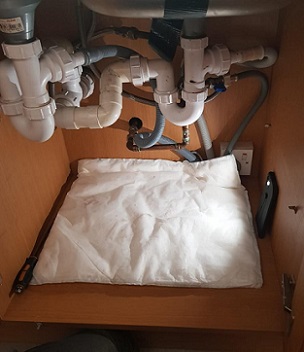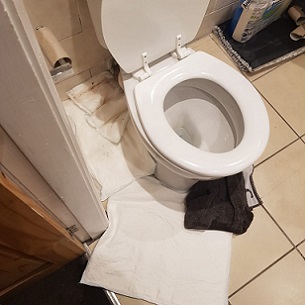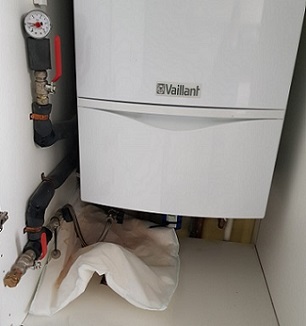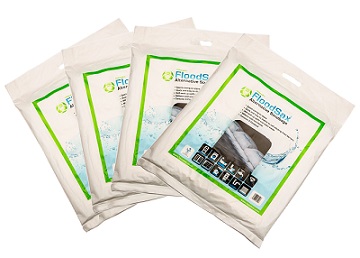 A FloodSax® in the bottom of a cupboard will absorb any leaks and drips from faulty pipework underneath the kitchen sink
A FloodSax® in the bottom of a cupboard will absorb any leaks and drips from faulty pipework underneath the kitchen sink
 These FloodSax® saved a lot of damage when a faulty pipe gave way on this toilet
These FloodSax® saved a lot of damage when a faulty pipe gave way on this toilet
 FloodSax® are ideal for popping under boilers to catch leaks and drips where the pipework means you can’t use a bucket or container
FloodSax® are ideal for popping under boilers to catch leaks and drips where the pipework means you can’t use a bucket or container
 FloodSax® can be placed under leaking radiators to stop the water from damaging carpets or flooring
FloodSax® can be placed under leaking radiators to stop the water from damaging carpets or flooring
 FloodSax® come in handy-sized bags making them easy and space-saving to store
FloodSax® come in handy-sized bags making them easy and space-saving to store
Drips and leaks can potentially cause enormous flood damage in homes and businesses with many in exceptionally hard-to-reach places so are virtually impossible to stop.
Yet super-absorbent FloodSax® are ultra-thin and have a large surface area so can be slipped beneath pipes, under floorboards and in tight spaces to soak up all the water until a plumber can arrive to sort out the problem.
In short, never ignore minor leaks as they are an indication that something is wrong and could suddenly get drastically worse and click here to find out how a plumber averted a flooding disaster using FloodSax®.
If you spot water where it shouldn't be in your home and business then take instant action to prevent or mitigate potential flooding.
Here is the definitive list of plumbing problems that can lead to drips, leaks or even floods in your home or business … and what causes them.
Leaks underneath the kitchen sink – there is usually a lot of pipework under there and people tend to store all kinds of cleaning products, brushes and even pans so the pipework is often getting knocked. This can easily cause a joint to get displaced and a leak can start. If it’s a more complicated problem a FloodSax® could completely cover and protect the cupboard floor and absorb all the dripping water.
Clogged guttering and downpipes – make sure they are regularly cleared otherwise when it rains heavily the water will overflow, possibly inside your cavity wall causing potentially severe water damage to your floors, ceilings and walls.
Leaking tap – if you turn it off too tightly you could damage the washer, leading to a leak.
Severe wet weather, storms and high winds will show up places in your home and businesses which need repairs such as faulty roof tiles or where pointing has been washed out of walls. Get them repaired or it could be far worse the next time as water quickly turns the small problems into bigger and more expensive ones.
Pipes underneath floorboards – if water pressure increases (perhaps you have had a new boiler fitted) the power could force some of the older joint fixings apart, leading to a leak. It’s far too small a space to get a bucket or a container under the dripping water but a FloodSax® would be ideal until a plumber can get to you. Most pipework can only stand a certain amount of water pressure.
Corroded pipes – old pipes can form tiny pinholes allowing potentially damaging amounts of water to escape. If your boiler water pressure keeps dropping quickly and you can’t see an obvious reason it means you probably have a leak under the floorboards somewhere which needs finding before it causes considerable damage.
Inlet pipe to the toilet – this can develop a leak if the toilet moves slightly although could quickly worsen into a major flood if it’s not fixed quickly. Always best to put FloodSax® around the toilet as a precaution in case the pipe suddenly gives way.
Leaking radiator valves – this problem commonly surfaces in the autumn when people turn their central heating back on and may be due to over-forcing the radiator control because they’ve stuck due to not being used for so long.
Water dripping from the shower hose – often caused by the hose simply getting too worn but hopefully the leaking water is contained in the bath or shower.
Pumps used to power water through to baths or showers – internal parts working loose often caused by years of vibration can lead to leaks and these are often in inaccessible places so a FloodSax® will be needed until the pump is repaired.
Leaking boilers – there are lost of places where leaks can start on boilers to best to invest in a quality one as the cheaper ones tend to develop most faults. If it’s dripping or leaking use a FloodSax® to absorb the water as you’ll struggle to get a bucket or container in there.
Water leaking from a bath or shower – this can be caused by grout wearing away or perhaps the area around the plughole becoming damaged. The main problem with these kind of leaks is they are hidden underneath the bath or shower so you’re unlikely to notice them until an unsightly water stain appears on the ceiling directly below.
Water coming out of the shower because the drain is blocked – hair and other debris can quickly block your shower drain so make sure you plunge or clean it out regularly because if water is backing up to the lip of the shower you’re not likely to notice it until it’s too late and it’s all over the bathroom floor and leaking through the ceiling to the room below.
Air conditioners produce condensation which causes moisture to drip from the evaporator coil into the drain pan. If you have a damaged drain pan or the drain is blocked with dirt and dust it can potentially lead to water dripping inside your home and through your walls. Ensure air conditioning units are regularly cleaned and maintained. A FloodSax® slipped under your air conditioner will soak up any leaks.
Seals corroded on water pipes into your appliances such as dishwashers, washing machines and fridges. You’ll also have rubber seals on your doors – around your dishwasher door and you can’t miss the big one on your washing machine. These can corrode over time so if you spot condensation on your appliances or puddles near it you may have a broken seal. FloodSax® slipped beneath the appliance and directly in front of it will soak the water up as it drips down. It’s very difficult to do with containers and if water gets into the floor it could badly damage it.
Loose hoses and pipes that supply water to your appliances – they can become loose over time, especially with all the vibration caused by the machine being used, and can start to leak. Just think how much your washing machine shakes during a spin cycle. Drips or even puddles on the floor near or under your appliances are a tell-tale sign something is leaking. You can slip a FloodSax® under it as a temporary measure.
Here are 5 signs that you may have a water leak inside your walls but can’t see it.
* Musty, pungent smell
* Mould on the walls.
* Stains, especially on the ceiling.
* Paint or wallpaper peeling is a sign of chronic moisture.
* In severe cases leaking water inside a wall could cause it to bend and become deformed.
FloodSax® can be used to tackle floods both inside and outside and are ideal for flood prevention, flood mitigation and flood control.
They resemble large pillowcases in their dry state but when they come into contact with water the special gelling polymer inside absorbs the water to inflate the FloodSax® to weigh 20kg (44lbs) in under 7 minutes.
Once expanded, a row of standard 500mm by 450mm by 200mm FloodSax® are strong enough to stop a powerful torrent of water in its tracks. Each row of FloodSax® will keep around 20cms (8ins) of water out and have proved themselves as flood barriers time and again worldwide. Their uniform size makes them easier to build into anti-flood barriers than sandbags.
In their dry state FloodSax® are exceptionally slim so inside homes and businesses they can be slipped under floorboards and pipes to catch water leaks and prevent further damage until a plumber can get there.
Almost 3 million FloodSax® sandless sandbags have been sold across the world over the last 13 years.
For more information on FloodSax® click here.